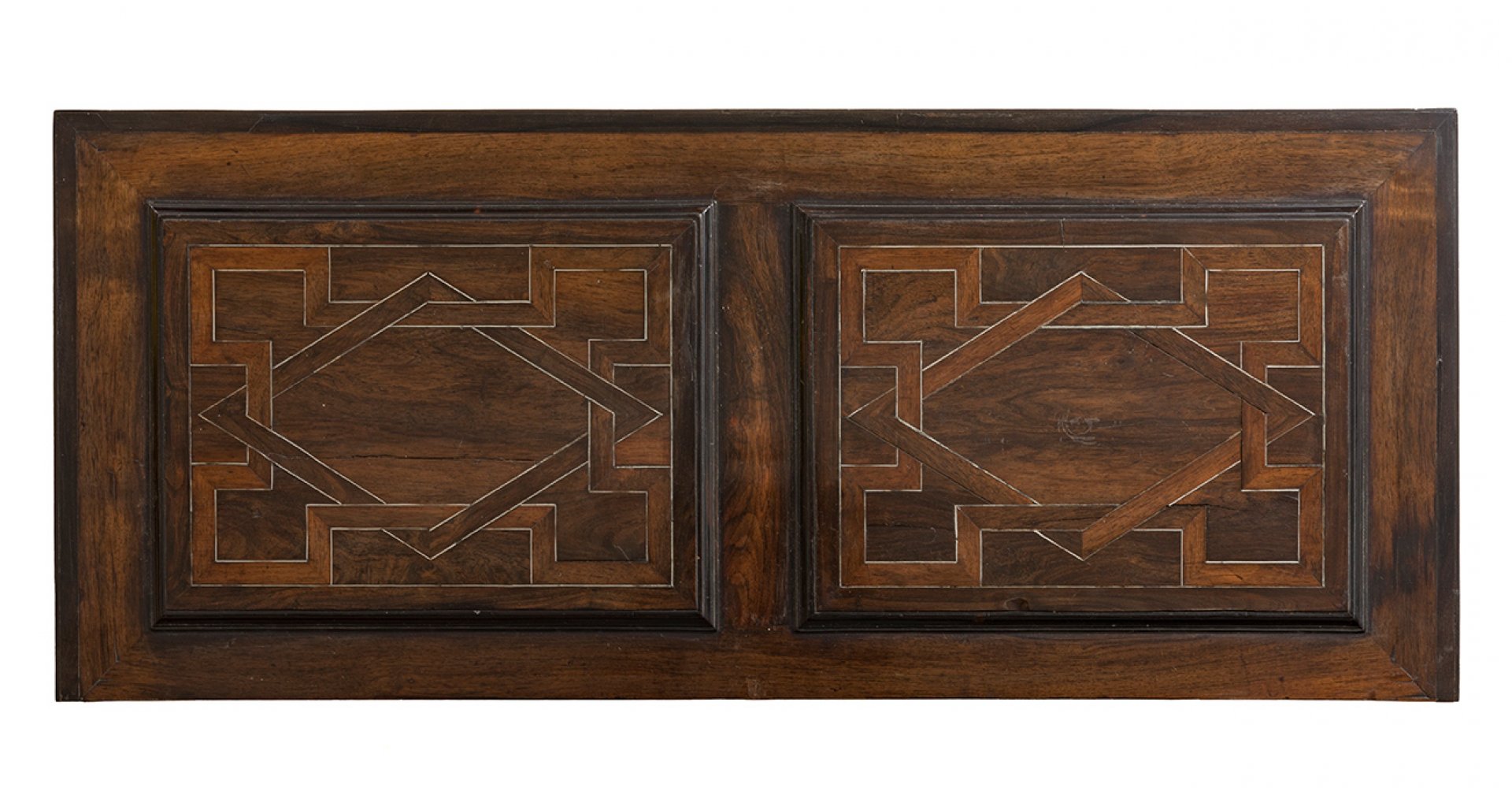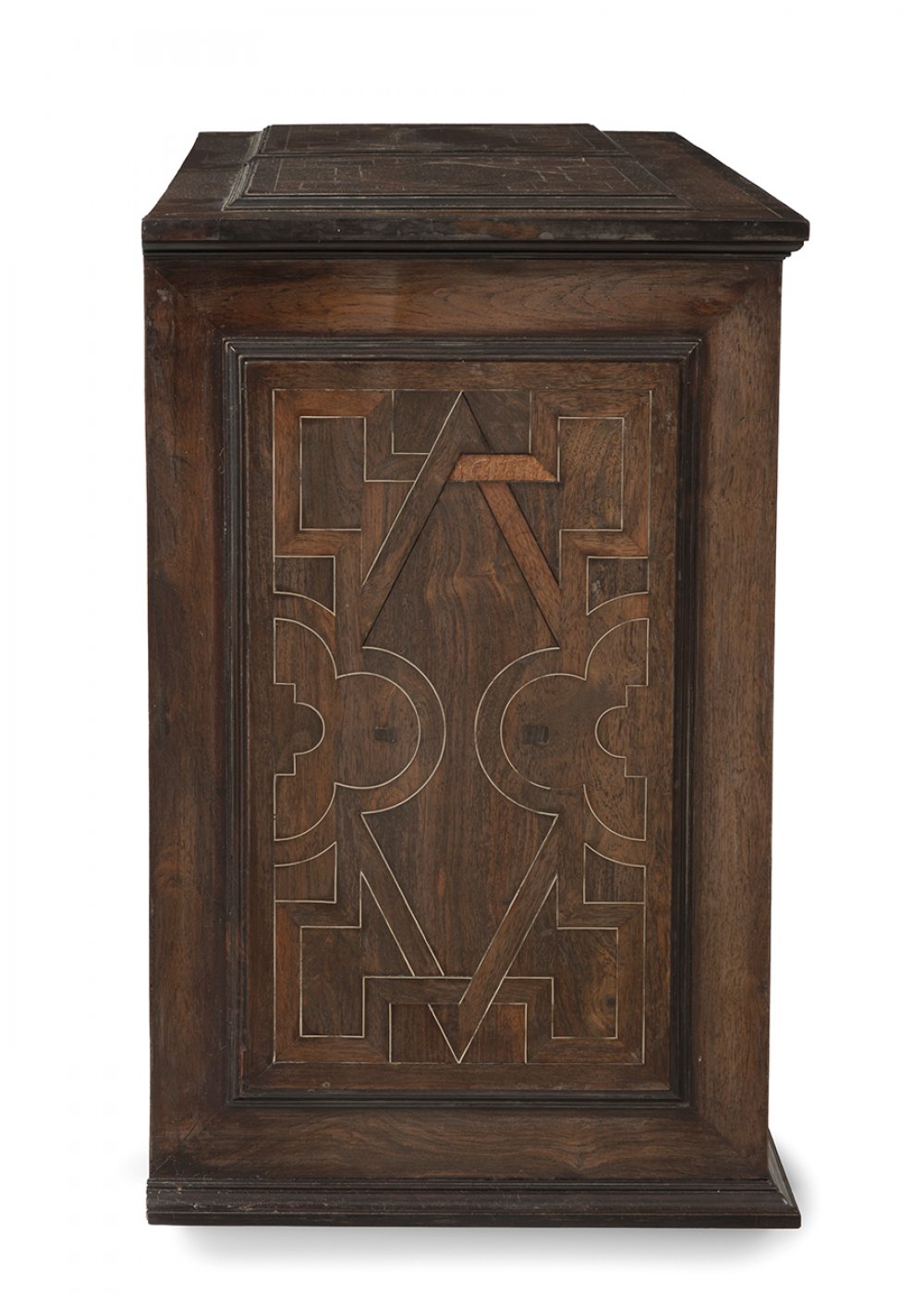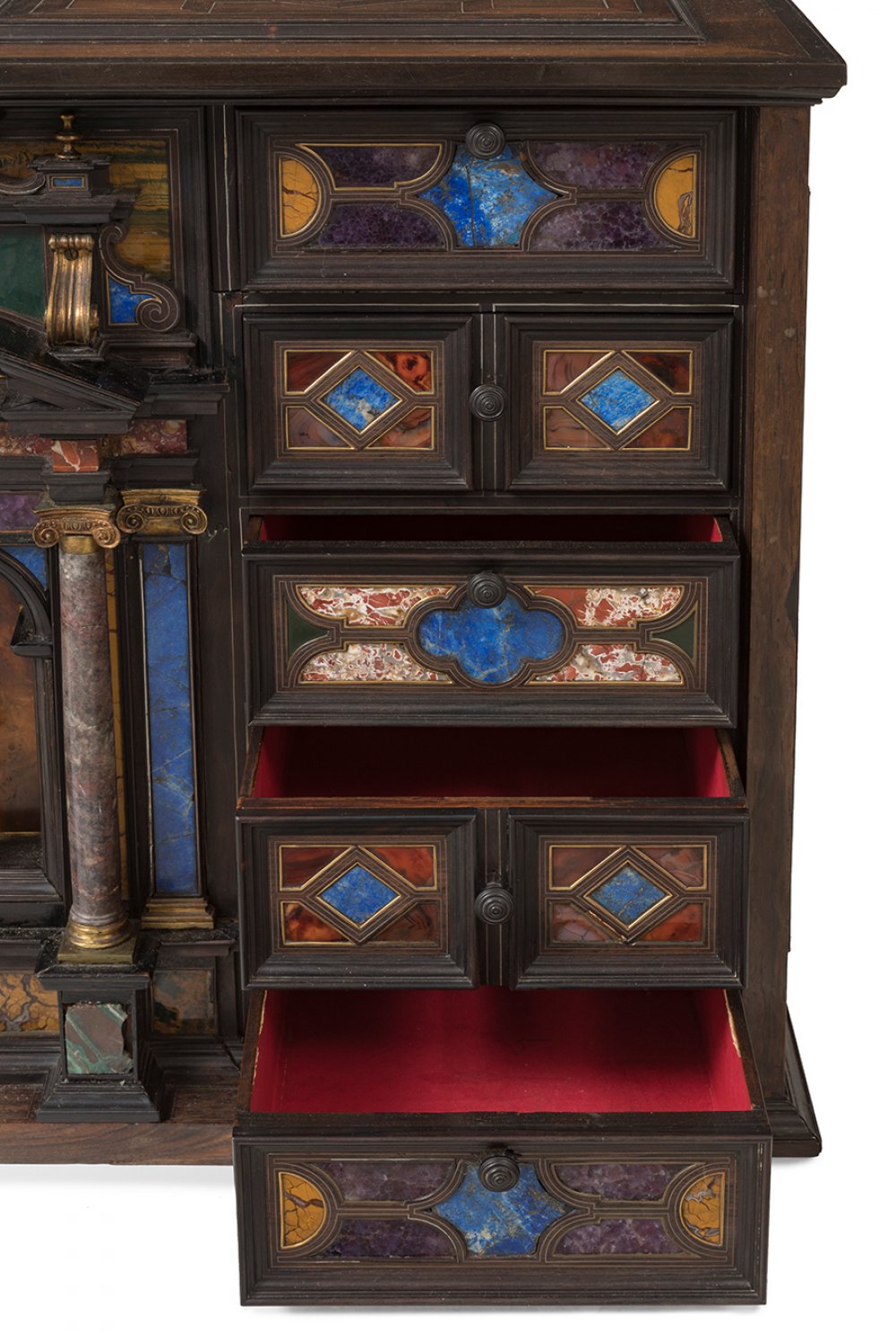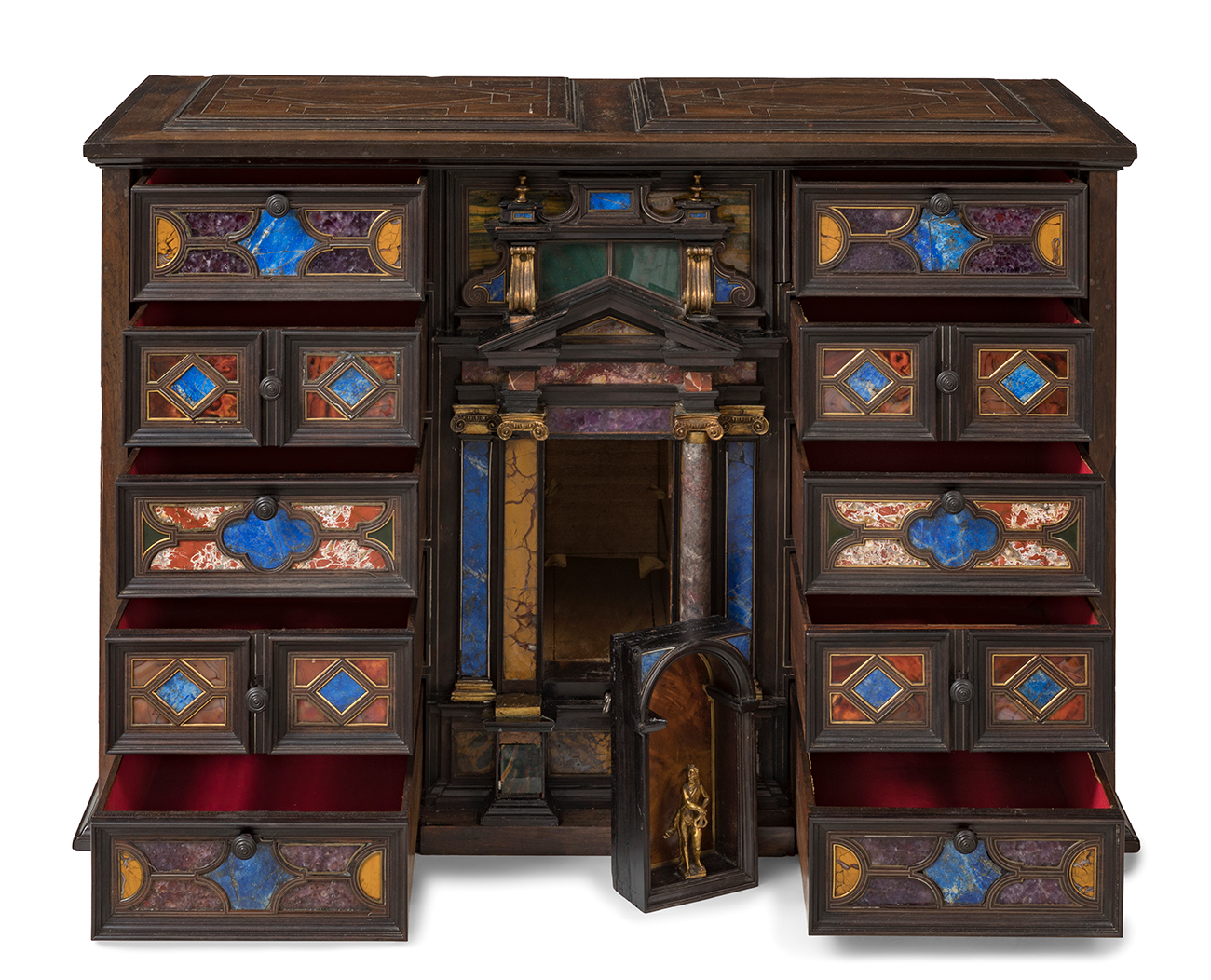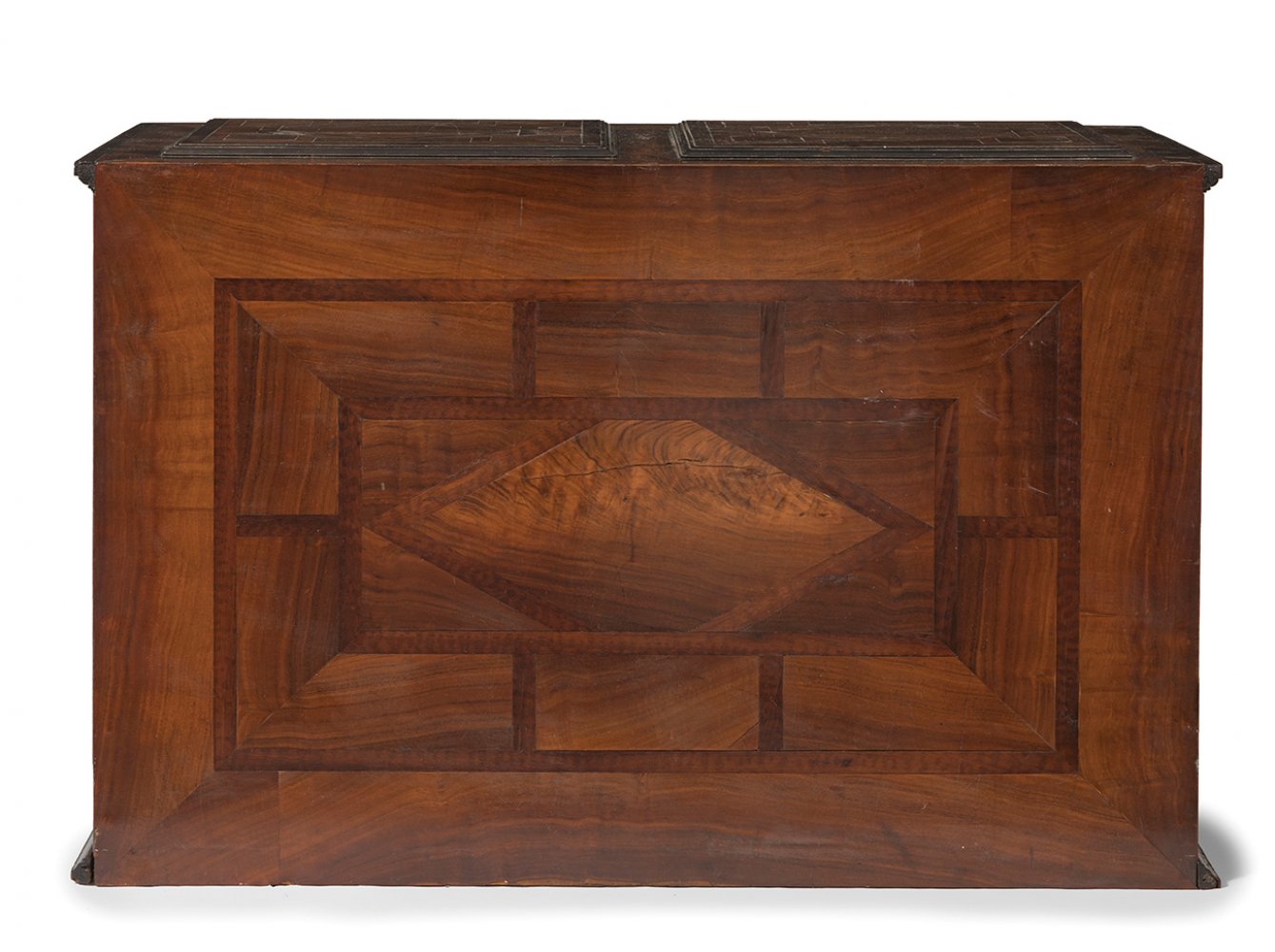4
Cabinet; Italy, 17th century.Wood, lapis lazuli, agate, jasper marble and bronze.It has an 18th-
1/7
Description
Cabinet; Italy, 17th century.
Wood, lapis lazuli, agate, jasper marble and bronze.
It has an 18th-century base.
It has faults, restorations and losses.
Measurements: 49 x 80 x 31 cm.
Italian cabinet from the 17th century, decorated with hard stones. It is a rectangular piece of furniture that stands on a base in the form of a smooth moulding. The front is divided into three sections separated by a column (the other is no longer preserved) of marbled marble, in Ionic order, with gilded bronze capitals and bases. The side sections, consisting of drawers, are decorated with mouldings, plaques and hard stones such as lapis lazuli, with round handles. The central body, topped by a pediment, contains a gilt-bronze sculpture of a young man holding a lyre, which suggests that it is a representation of the god Apollo. The sides of the cabinet are considerably simpler in decoration, although in the same style and with the same proportions. The decoration consists of recesses made up of inlaid fillets, combining different geometric shapes inscribed in rectangles. It should be noted that the cabernet hides several secret compartments that can be accessed by removing the main drawers.
It is a piece that faithfully follows Italian models, in which it was common to combine different materials in search of chromatic and quality contrasts. The markedly architectural structure is also typical of the Italian school and, in fact, even the typology itself, given that in the 17th century the cabinet or desk was the furniture par excellence throughout Europe.
Wood, lapis lazuli, agate, jasper marble and bronze.
It has an 18th-century base.
It has faults, restorations and losses.
Measurements: 49 x 80 x 31 cm.
Italian cabinet from the 17th century, decorated with hard stones. It is a rectangular piece of furniture that stands on a base in the form of a smooth moulding. The front is divided into three sections separated by a column (the other is no longer preserved) of marbled marble, in Ionic order, with gilded bronze capitals and bases. The side sections, consisting of drawers, are decorated with mouldings, plaques and hard stones such as lapis lazuli, with round handles. The central body, topped by a pediment, contains a gilt-bronze sculpture of a young man holding a lyre, which suggests that it is a representation of the god Apollo. The sides of the cabinet are considerably simpler in decoration, although in the same style and with the same proportions. The decoration consists of recesses made up of inlaid fillets, combining different geometric shapes inscribed in rectangles. It should be noted that the cabernet hides several secret compartments that can be accessed by removing the main drawers.
It is a piece that faithfully follows Italian models, in which it was common to combine different materials in search of chromatic and quality contrasts. The markedly architectural structure is also typical of the Italian school and, in fact, even the typology itself, given that in the 17th century the cabinet or desk was the furniture par excellence throughout Europe.
Auction Details
Shipping
T&Cs & Important Info
Ask seller a question
Cabinet; Italy, 17th century.
Wood, lapis lazuli, agate, jasper marble and bronze.
It has an 18th-century base.
It has faults, restorations and losses.
Measurements: 49 x 80 x 31 cm.
Italian cabinet from the 17th century, decorated with hard stones. It is a rectangular piece of furniture that stands on a base in the form of a smooth moulding. The front is divided into three sections separated by a column (the other is no longer preserved) of marbled marble, in Ionic order, with gilded bronze capitals and bases. The side sections, consisting of drawers, are decorated with mouldings, plaques and hard stones such as lapis lazuli, with round handles. The central body, topped by a pediment, contains a gilt-bronze sculpture of a young man holding a lyre, which suggests that it is a representation of the god Apollo. The sides of the cabinet are considerably simpler in decoration, although in the same style and with the same proportions. The decoration consists of recesses made up of inlaid fillets, combining different geometric shapes inscribed in rectangles. It should be noted that the cabernet hides several secret compartments that can be accessed by removing the main drawers.
It is a piece that faithfully follows Italian models, in which it was common to combine different materials in search of chromatic and quality contrasts. The markedly architectural structure is also typical of the Italian school and, in fact, even the typology itself, given that in the 17th century the cabinet or desk was the furniture par excellence throughout Europe.
Wood, lapis lazuli, agate, jasper marble and bronze.
It has an 18th-century base.
It has faults, restorations and losses.
Measurements: 49 x 80 x 31 cm.
Italian cabinet from the 17th century, decorated with hard stones. It is a rectangular piece of furniture that stands on a base in the form of a smooth moulding. The front is divided into three sections separated by a column (the other is no longer preserved) of marbled marble, in Ionic order, with gilded bronze capitals and bases. The side sections, consisting of drawers, are decorated with mouldings, plaques and hard stones such as lapis lazuli, with round handles. The central body, topped by a pediment, contains a gilt-bronze sculpture of a young man holding a lyre, which suggests that it is a representation of the god Apollo. The sides of the cabinet are considerably simpler in decoration, although in the same style and with the same proportions. The decoration consists of recesses made up of inlaid fillets, combining different geometric shapes inscribed in rectangles. It should be noted that the cabernet hides several secret compartments that can be accessed by removing the main drawers.
It is a piece that faithfully follows Italian models, in which it was common to combine different materials in search of chromatic and quality contrasts. The markedly architectural structure is also typical of the Italian school and, in fact, even the typology itself, given that in the 17th century the cabinet or desk was the furniture par excellence throughout Europe.
29th December - Old Masters
Sale Date(s)
Venue Address
Aragón 346, Barcelona
Calle Velázquez 7, Madrid
Carrer de Cirilo Amorós 55, Valencia
Barcelona
08009
Spain
General delivery information available from the auctioneer
Setdart offers Worldwide shipping
PICK UP IN ROOM: You can come and pick up your lots in our offices (Barcelona, Madrid or Valencia). At the moment of the withdrawal, you will be able to accept the current conditions of the lot by means of a document that you will sign.
YOU CAN SEND ANOTHER PERSON TO PICK UP: This person must present a signed authorization that you can find in our web page by accessing from BUY AT SETDART- LOGISTICS-DOWNLOAD AUTHORIZATION DOCUMENT. You can also send an e-mail with the requested data in AUTHORIZATION DOCUMENT to admin@setdart.com
Important Information
25% buyer´s premium
21% buyer´s premium at www.setdart.com
















